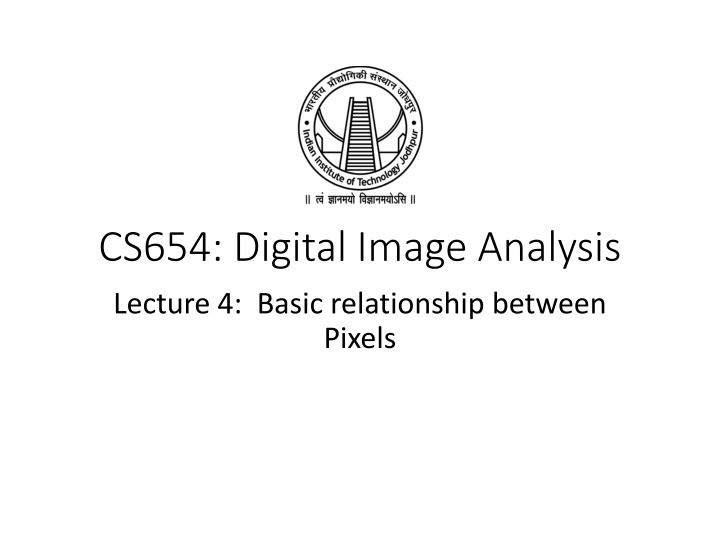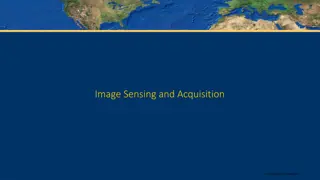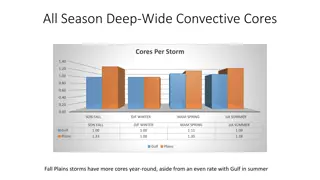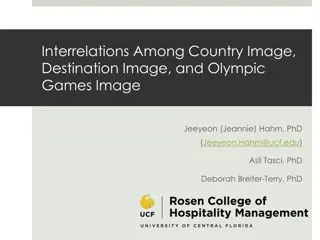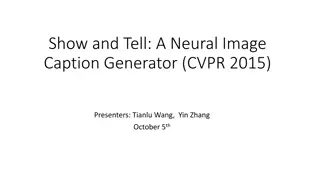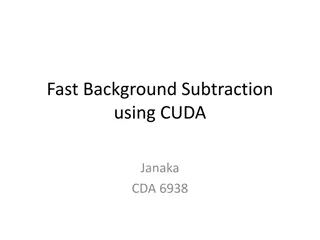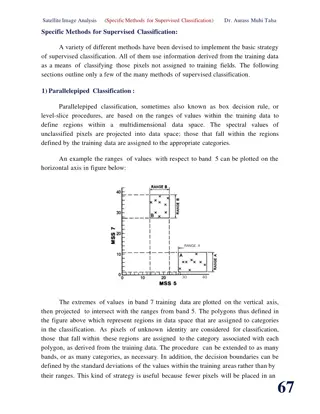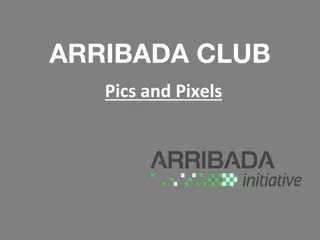Basic Relationship Between Image Pixels
This article delves into the fundamental aspects of digital image analysis, covering topics such as pixel relationships, neighbourhood connectivity, adjacency, and distance metrics like Euclidean and City block. It also explores the definitions, neighbors, and connectivity of pixels in images.
Download Presentation

Please find below an Image/Link to download the presentation.
The content on the website is provided AS IS for your information and personal use only. It may not be sold, licensed, or shared on other websites without obtaining consent from the author.If you encounter any issues during the download, it is possible that the publisher has removed the file from their server.
You are allowed to download the files provided on this website for personal or commercial use, subject to the condition that they are used lawfully. All files are the property of their respective owners.
The content on the website is provided AS IS for your information and personal use only. It may not be sold, licensed, or shared on other websites without obtaining consent from the author.
E N D
Presentation Transcript
CS654: Digital Image Analysis Lecture 4: Basic relationship between Pixels
Recap of Lecture 3 Issues with sampling and quantization Quality and size trade-off Data structure to store image information Matrices Integral image Topological Graph Hierarchical Pyramid, Quadtree
Highlights of Lecture 4 Relationship between image pixels Neighbourhood Connectivity Adjacency Path Distance metric Euclidean, City block, Chess board distance, Geodesic distance
Definitions f(x,y): digital image Pixels: q, p Subset of pixels of f(x,y): S p q
Neighbors of a Pixel A pixel p at coordinates (x,y) has four horizontal and vertical neighbors whose coordinates are given by: (x+1,y), (x-1, y), (x, y+1), (x,y-1) (x-1, y) (x, y-1) p (x, y) (x, y+1) (x+1, y)
Neighbourhood This set of pixels, called the 4-neighbors or p, is denoted by N4(p). Each pixel is one unit distance from (x,y) Some of the neighbors of p lie outside the digital image
Neighbors of a Pixel: Diagonal The four diagonal neighbors of p have coordinates: (x+1, y+1), (x+1, y-1), (x-1, y+1), (x-1, y-1) (x-1, y-1) (x-1, y+1) p (x,y) (x+1, y-1) (x+1, y+1) and are denoted by ND (p).
Neighbourhood: 8-neighbours Diagonal and the 4-neighbors, together are called the 8-neighbors of p Denoted by N8 (p). ?8? = ?4? ??(?) (x-1, y-1) (x-1, y) (x-1, y+1) (x, y-1) p (x,y) (x, y+1) (x+1, y-1) (x, y+1) (x+1, y+1) Some of the points in ND (p) and N8 (p) fall outside the image
Connectivity It is used in establishing boundaries of objects and components of regions in an image A pixel is connected to its neighbor when it has the same property V is the setof gray-level values used to define adjacency V set can be any subset of these 256 values. For binary image ??
Different types of connectivity V = { } p p p 4-connected 8-connected m-connected
Adjacency A pixel p is adjacent to a pixel q, if they are connected. 1. 4-adjacency: Two pixels p and q with values from V are 4-adjacent if q is in the set N4(p). 2. 8-adjacency: Two pixels p and q with values from V are 8-adjacent if q is in the set N8(p). 3. m-adjacency =(mixed) Depending upon the connectivity used
Types of Adjacency Mixed adjacency is a modification of 8- adjacency. It is introduced to eliminate the ambiguities that often arise when 8-adjacency is used. For example:
Types of Adjacency In this example, we can note that to connect between two pixels (finding a path between two pixels): In 8-adjacency way, you can find multiple paths between two pixels While, in m-adjacency, you can find only one path between two pixels So, m-adjacency has eliminated the multiple path connection that has been generated by the 8-adjacency.
Adjacent regions Two subsets S1 and S2 are adjacent, if some pixel in S1 is adjacent to some pixel in S2. Adjacent means, either 4-, 8- or m-adjacency. Region 1 Region 2
A Digital Path A digital path from pixel p with coordinate (x,y) to pixel q with coordinate (s,t) is a sequence of distinct pixels (x0,y0), (x1,y1), , (xn, yn) where (x0,y0) = (x,y) and (xn, yn) = (s,t) Pixels (xi, yi) and (xi-1, yi-1) are adjacent for 1 i n n is the length of the path If (x0,y0) = (xn, yn), the path is closed.
A Digital Path Return to the previous example: In figure (b) the paths between the top right and bottom right pixels are 8-paths. And the path between the same 2 pixels in figure (c) is m-path
Connected component Let ? ? and ?,? ? Then ? is connected to ? in ? if there exist a path from ? ?? ? consisting entirely of pixels of ? For any such p ?,the set of pixels in ? that are connected to ? is called connected components of ? Any two pixels of a connected component are connected to each other Distinct connected components are disjoint
Connected component labeling (CCL) Ability to assign different labels to various disjoint connected components Connected-component analysis, Blob extraction, Region labeling, Blob discovery, or Region extraction Connected-component labeling is not to be confused with segmentation.
Algorithm for CCL Scan an image from left to right and from top to bottom Assume 4-connectivity P be a pixel at any step in the scanning process r t p Before pixel p, pixel r and t are scanned
Steps of CCL Algorithm: Pass 1 I(p) : pixel value at position p L(p): Label assigned to pixel location p 1. If I(p) = 0, then move to next scanning position 2. If I(p) = 1 and I(r) = I(t) = 0, then 3. Assign a new label to position p 4. If I(p) = 1 and only one of the two neighbor is 1, then Assign its label to p 5. 6. If I(p) = 1 and both r and t are 1 s, then 7. If L(r) = L(t) then L(p) = L(r) 8. If L(r) != L(t) then 9. assign on of the labels to p and make a note that the two labels are quivalent
CCL: Pass 2 After all the pixels are processed once, Pixels with value 1 are labeled Some labels are equivalent During 2nd pass (post-processing), process the equivalent pixels to form equivalent classes Assign a different label to each class Each pixel is labeled with the class label
CCL: Example 0 0 0 0 0 0 0 0 0 0 0 0 0 0 0 0 0 0 0 1 1 0 0 1 1 0 0 1 1 0 0 1 1 0 0 1 1 1 1 1 1 1 1 0 0 1 1 1 1 0 0 0 0 0 1 1 1 1 0 0 0 1 1 1 1 0 0 0 0 0 1 1 1 1 0 0 0 1 1 1 0 0 1 1 0 0 1 1 1 0 0 1 1 0 0 0 1 1 1 0 0 0 0 0 1 1 0 0 0 0 0 1 1 0 0 0 1 1 0 0 0 0 0 0 0 1 1 1 1 0 0 1 1 1 1 0 0 0 0 0 0 0 0 0 0 0 0 0 0 0 0 0 0
CCL: Example 0 0 0 0 0 0 0 0 0 0 0 0 0 0 0 0 0 0 0 1 1 0 0 1 1 0 0 1 1 0 0 1 1 0 0 1 1 1 1 1 1 1 1 0 0 1 1 1 1 0 0 0 0 0 1 1 1 1 0 0 0 1 1 1 1 0 0 0 0 0 1 1 1 1 0 0 0 1 1 1 0 0 1 1 0 0 1 1 1 0 0 1 1 0 0 0 1 1 1 0 0 0 0 0 1 1 0 0 0 0 0 1 1 0 0 0 1 1 0 0 0 0 0 0 0 1 1 1 1 0 0 1 1 1 1 0 0 0 0 0 0 0 0 0 0 0 0 0 0 0 0 0 0 Equivalent labels
CCL: Example 0 0 0 0 0 0 0 0 0 0 0 0 0 0 0 0 0 0 0 1 1 0 0 1 1 0 0 1 1 0 0 1 1 0 0 1 1 1 1 1 1 1 1 0 0 1 1 1 1 0 0 0 0 0 1 1 1 1 0 0 0 1 1 1 1 0 0 0 0 0 1 1 1 1 0 0 0 1 1 1 0 0 1 1 0 0 1 1 1 0 0 1 1 0 0 0 1 1 1 0 0 0 0 0 1 1 0 0 0 0 0 1 1 0 0 0 1 1 0 0 0 0 0 0 0 1 1 1 1 0 0 1 1 1 1 0 0 0 0 0 0 0 0 0 0 0 0 0 0 0 0 0 0
Thank you Next Lecture: Neighbourhood Relationship (Contd.)
